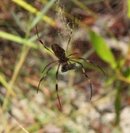Turneffe Flats
Registered
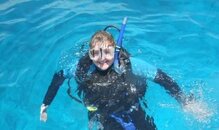
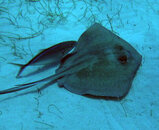
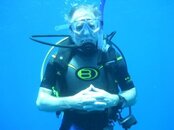
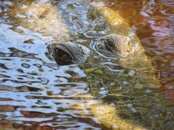
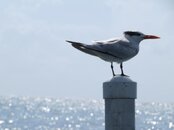
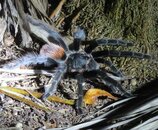
HAPPY DIVERS & SOME TURNEFFE ISLANDS FAUNA
4 – 9 May, 2014
Air Temperatures – Mid to high 80’s
Water Temperature – 82F
On Sunday morning, winds were coming from north at about 10 knots, and then switched to a light breeze from the northwest on Monday, which tapered out to little and no wind for the rest of that day. A light northerly greeted us on Tuesday morning, but this switched to an easterly, and gradually picked up speed throughout the day. Wednesday started out with 10 – 20 knot easterly winds which dominated surface conditions for the remainder of the week, forcing diving from the west side of the atoll only. Hazy to partly cloudy conditions were present all week, with very few scattered showers.
Divemaster Denroy was Boat Capt, and Dive Master John was Dive Guide for the week. Due to the northerly winds, the dive team chose the northeastern side of the atoll for diving on the walls outside of Cockroach Caye. Dive one started at Lettuce Lane with 80 feet of visibility, then Lindsay’s Back Porch with reduced visibility of 60 feet for dive two, and Cockroach Caye Shallows for dive three with the same 60 feet of visibility. Key sightings for the day were pretty good with a rarely witnessed fight between two Green Moray Eels that were obviously battling out territorial rights. Two tiny, beautifully detailed juvenile Spotted Drums, a Batwing Coral Crab, Spinyhead Blenny, Banded Coral, Pederson and Pistol Shrimp, a Spotted Eagle Ray, and several Caribbean Spiny Lobster. The highlight was a large male Loggerhead Turtle who swam through the divers not seeming to notice that they were there. His travelling companions were equally interesting, as this turtle had four very large Remoras attached to its back and a 3-foot long Cobia swimming along behind.
Due to the continued northwesterly, we were able to take advantage of dive sites to the southwest near Calabash Caye, and Jojo’s Split, Chrissea’s Place, and Calabash Caye Wall were chosen finding visibility of 60 feet at these sites. We know its turtle mating season this time of year, but it is always heart-warming to see the Loggerheads doing what they migrated back to these parts to do, as Captain Denroy observed a pair of Loggerheads mating on the surface during dive one. A massive male Loggerhead named “Barnacle Bill”, after the numerous large barnacles growing on his shell, has returned to the area and was observed on dive two picking up a conch to crush and eat with its large beak on the first dive. One can only imagine the damage this animal could do to a human hand should it feel so inclined. Barnacle Bill is now measuring well over 5 feet in length, and is truly an impressive creature. He was in no hurry and worked this area of reef systematically as he was observed on the second dive only and swam directly over divers heading for his next feeding location, or female. In addition, Dive Master John coaxed three White Spotted Toadfish out of their coral hole hideaways. However, it must be said that John is an expert at this, and can easily be called a Toadfish Whisperer.
Knowing what the forecast indicated for the next couple of days with increased winds from the east, it was decided that Tuesday would be the best day for our visit to Lighthouse Reef and the Blue Hole. Visibility was not the best at 40 feet in the Blue Hole. However, the Caribbean Reef Sharks cooperated coming closer for a better view and divers were able to see three sleek 6-foot specimens, together with a few chunky Midnight Parrots with large mossy beaks on the edge of the hole. Half Moon Caye Wall yielded sightings of Green Turtles, Southern Stingrays, Great Barracuda, as well as Hogfish and bright Blue Parrots feeding in the white sand bed. No visit to Lighthouse Reef is complete without our lunch stop at Half Moon Caye to see the Red-Footed Boobie Birds in the littoral forest of Zircote and Coconut Trees, and enjoying the views from the white sand water’s edge on either side of this stunningly beautiful island, so we made sure to fit that in. Aquarium, on the west side of Long Caye, was chosen as the third dive site. Here divers found more Great Barracuda, Mackerel, a Spotted Eagle Ray, two Permit, and as many as eight Tarpon along this dramatic and busy wall. A very interesting and surprising find was a Giant Split-Pore Sea Rod soft coral actually spawning in broad daylight.
By Wednesday morning, the wind had whipped itself up to steady 15 knots out of the east, and divers headed west under cover of the leeward side of the atoll. Since today was scheduled for our Night Dive, divers completed only 2 morning dives at Creekozene North, and Creekozene South. Dive Master John decided to include a Lionfish hunt for both these dives. As a result, he had a few large Mutton Snappers following along at a safe distance and two hefty Black Groupers not far behind. A Great Barracuda came in close to eye the action being drawn in by the vibration of dying fish, but he moved off when faced with competition from the snappers and groupers. As divers moved over the sand bed on Creekozene South, they saw a large tan coloured Mantis Shrimp foraging in the sand not far from it’s perfectly round carved out hole in the sand. As soon as it realized it was being observed, it darted back to the safety of its lair tucking in tail first. The Night Dive set out at 6pm and divers found the usual nocturnal activity starting up just after dark on this shallow reef near the resort. Apart from the usual suspects like Caribbean Spiny Lobster, Tiger Tail Sea Cucumbers, Sea Urchins and Burrfish hiding in soft corals, divers found two Lettuce Leaf Slugs, an Octopus, and a dead Sea Hare. It seems something had been feeding on the Sea Hare, but the culprit was nowhere to be seen, more than likely a crab, lobster or the predatory Queen Helmet Conch.
Strong easterly winds prevailed on Thursday, so divers headed for the northwest side of Turneffe and dived at the Terrace and Chasbow’s Corner for the first two dives with visibility of 60 and 70 feet respectively. Dive Instructor Anne-Marie tagged along and played dive guide for today’s dives. She was able to point out a perfect example of a Viscous Sponge hanging from an outcropping on Terrace’s vertical wall, and bushes of Black Coral along with scrolling strands of Wire Coral. Chasbow’s Corner boasts dense growth of Deep Water Gorgonian Sea Fans that draw in a number of species. Divers found many Caribbean Spiny Lobster, Tiger Groupers, Honey Combed Trunk Fish, Lizardfish and a Large Eagle Ray passing by. Upon close inspection of the Wire Coral there, divers examined Wire Coral Shrimp with a magnifying glass. Elgene’s Inn to the south on the mid-west side of the atoll was chosen as the third dive site. Visibility was barely 40 feet here with an outgoing tide and the easterly wind blowing off the inner lagoon water on this site. Divers assumed they’d have to pull out the magnifying glass again to look at small critters up close in this visibility. They got the surprise of the year, as they looked up from two juvenile Spotted Drums and saw the tail of a Manatee as it swam off and just out of range in the low visibility. Intuitively, everyone started looking around in case there were more, and sure enough, two Manatee with their bulky bodies and flat, round-ended tails swam by overhead, so close one could see the barnacles growing on them. It seems that one was leading the way, and then it decided to double back for a swim-by to check out the divers. One could hear the cheering and exclamations of amazement from the divers underwater. What luck we all thought. Too bad one diver had decided to leave his camera on board for this dive. Putting our heads back down and combing the bottom for other interesting creatures, we came across several School Master Snapper and Yellow Tail Snapper gathering on the edge of the wall. Then, someone looked up and noticed the same pair of Manatee had decided to circle us two more times again. Amazing! We see dolphins underwater here much more frequently than Manatee, this was truly a special treat for the divers. Belize has a healthy population of these marine mammals, although they are endangered and protected here in Belize. As if that wasn’t enough, divers went on to find a Nurse Shark hiding in a sand channel with its head buried under a coral head, and then a Spotted Eagle Ray swam right up to divers giving everyone an up close view.
On Friday, divers headed for the northwest again with the continued strong easterly winds blowing. Divers visited Elkin’s Bay for dive one, and Tunnels & Barrels for dive two finding 70 feet of visibility on both dives. Hawksbill Turtles were the flavor of the day, with sightings of Green Moray Eels, Black Grouper and more species of sponges than one could count finishing off an absolutely splendid week of diving. 4 – 9 May, 2014
Air Temperatures – Mid to high 80’s
Water Temperature – 82F
On Sunday morning, winds were coming from north at about 10 knots, and then switched to a light breeze from the northwest on Monday, which tapered out to little and no wind for the rest of that day. A light northerly greeted us on Tuesday morning, but this switched to an easterly, and gradually picked up speed throughout the day. Wednesday started out with 10 – 20 knot easterly winds which dominated surface conditions for the remainder of the week, forcing diving from the west side of the atoll only. Hazy to partly cloudy conditions were present all week, with very few scattered showers.
Divemaster Denroy was Boat Capt, and Dive Master John was Dive Guide for the week. Due to the northerly winds, the dive team chose the northeastern side of the atoll for diving on the walls outside of Cockroach Caye. Dive one started at Lettuce Lane with 80 feet of visibility, then Lindsay’s Back Porch with reduced visibility of 60 feet for dive two, and Cockroach Caye Shallows for dive three with the same 60 feet of visibility. Key sightings for the day were pretty good with a rarely witnessed fight between two Green Moray Eels that were obviously battling out territorial rights. Two tiny, beautifully detailed juvenile Spotted Drums, a Batwing Coral Crab, Spinyhead Blenny, Banded Coral, Pederson and Pistol Shrimp, a Spotted Eagle Ray, and several Caribbean Spiny Lobster. The highlight was a large male Loggerhead Turtle who swam through the divers not seeming to notice that they were there. His travelling companions were equally interesting, as this turtle had four very large Remoras attached to its back and a 3-foot long Cobia swimming along behind.
Due to the continued northwesterly, we were able to take advantage of dive sites to the southwest near Calabash Caye, and Jojo’s Split, Chrissea’s Place, and Calabash Caye Wall were chosen finding visibility of 60 feet at these sites. We know its turtle mating season this time of year, but it is always heart-warming to see the Loggerheads doing what they migrated back to these parts to do, as Captain Denroy observed a pair of Loggerheads mating on the surface during dive one. A massive male Loggerhead named “Barnacle Bill”, after the numerous large barnacles growing on his shell, has returned to the area and was observed on dive two picking up a conch to crush and eat with its large beak on the first dive. One can only imagine the damage this animal could do to a human hand should it feel so inclined. Barnacle Bill is now measuring well over 5 feet in length, and is truly an impressive creature. He was in no hurry and worked this area of reef systematically as he was observed on the second dive only and swam directly over divers heading for his next feeding location, or female. In addition, Dive Master John coaxed three White Spotted Toadfish out of their coral hole hideaways. However, it must be said that John is an expert at this, and can easily be called a Toadfish Whisperer.
Knowing what the forecast indicated for the next couple of days with increased winds from the east, it was decided that Tuesday would be the best day for our visit to Lighthouse Reef and the Blue Hole. Visibility was not the best at 40 feet in the Blue Hole. However, the Caribbean Reef Sharks cooperated coming closer for a better view and divers were able to see three sleek 6-foot specimens, together with a few chunky Midnight Parrots with large mossy beaks on the edge of the hole. Half Moon Caye Wall yielded sightings of Green Turtles, Southern Stingrays, Great Barracuda, as well as Hogfish and bright Blue Parrots feeding in the white sand bed. No visit to Lighthouse Reef is complete without our lunch stop at Half Moon Caye to see the Red-Footed Boobie Birds in the littoral forest of Zircote and Coconut Trees, and enjoying the views from the white sand water’s edge on either side of this stunningly beautiful island, so we made sure to fit that in. Aquarium, on the west side of Long Caye, was chosen as the third dive site. Here divers found more Great Barracuda, Mackerel, a Spotted Eagle Ray, two Permit, and as many as eight Tarpon along this dramatic and busy wall. A very interesting and surprising find was a Giant Split-Pore Sea Rod soft coral actually spawning in broad daylight.
By Wednesday morning, the wind had whipped itself up to steady 15 knots out of the east, and divers headed west under cover of the leeward side of the atoll. Since today was scheduled for our Night Dive, divers completed only 2 morning dives at Creekozene North, and Creekozene South. Dive Master John decided to include a Lionfish hunt for both these dives. As a result, he had a few large Mutton Snappers following along at a safe distance and two hefty Black Groupers not far behind. A Great Barracuda came in close to eye the action being drawn in by the vibration of dying fish, but he moved off when faced with competition from the snappers and groupers. As divers moved over the sand bed on Creekozene South, they saw a large tan coloured Mantis Shrimp foraging in the sand not far from it’s perfectly round carved out hole in the sand. As soon as it realized it was being observed, it darted back to the safety of its lair tucking in tail first. The Night Dive set out at 6pm and divers found the usual nocturnal activity starting up just after dark on this shallow reef near the resort. Apart from the usual suspects like Caribbean Spiny Lobster, Tiger Tail Sea Cucumbers, Sea Urchins and Burrfish hiding in soft corals, divers found two Lettuce Leaf Slugs, an Octopus, and a dead Sea Hare. It seems something had been feeding on the Sea Hare, but the culprit was nowhere to be seen, more than likely a crab, lobster or the predatory Queen Helmet Conch.
Strong easterly winds prevailed on Thursday, so divers headed for the northwest side of Turneffe and dived at the Terrace and Chasbow’s Corner for the first two dives with visibility of 60 and 70 feet respectively. Dive Instructor Anne-Marie tagged along and played dive guide for today’s dives. She was able to point out a perfect example of a Viscous Sponge hanging from an outcropping on Terrace’s vertical wall, and bushes of Black Coral along with scrolling strands of Wire Coral. Chasbow’s Corner boasts dense growth of Deep Water Gorgonian Sea Fans that draw in a number of species. Divers found many Caribbean Spiny Lobster, Tiger Groupers, Honey Combed Trunk Fish, Lizardfish and a Large Eagle Ray passing by. Upon close inspection of the Wire Coral there, divers examined Wire Coral Shrimp with a magnifying glass. Elgene’s Inn to the south on the mid-west side of the atoll was chosen as the third dive site. Visibility was barely 40 feet here with an outgoing tide and the easterly wind blowing off the inner lagoon water on this site. Divers assumed they’d have to pull out the magnifying glass again to look at small critters up close in this visibility. They got the surprise of the year, as they looked up from two juvenile Spotted Drums and saw the tail of a Manatee as it swam off and just out of range in the low visibility. Intuitively, everyone started looking around in case there were more, and sure enough, two Manatee with their bulky bodies and flat, round-ended tails swam by overhead, so close one could see the barnacles growing on them. It seems that one was leading the way, and then it decided to double back for a swim-by to check out the divers. One could hear the cheering and exclamations of amazement from the divers underwater. What luck we all thought. Too bad one diver had decided to leave his camera on board for this dive. Putting our heads back down and combing the bottom for other interesting creatures, we came across several School Master Snapper and Yellow Tail Snapper gathering on the edge of the wall. Then, someone looked up and noticed the same pair of Manatee had decided to circle us two more times again. Amazing! We see dolphins underwater here much more frequently than Manatee, this was truly a special treat for the divers. Belize has a healthy population of these marine mammals, although they are endangered and protected here in Belize. As if that wasn’t enough, divers went on to find a Nurse Shark hiding in a sand channel with its head buried under a coral head, and then a Spotted Eagle Ray swam right up to divers giving everyone an up close view.
On Friday, divers headed for the northwest again with the continued strong easterly winds blowing. Divers visited Elkin’s Bay for dive one, and Tunnels & Barrels for dive two finding 70 feet of visibility on both dives. Hawksbill Turtles were the flavor of the day, with sightings of Green Moray Eels, Black Grouper and more species of sponges than one could count finishing off an absolutely splendid week of diving.




